Spring 2020 Emergent Field Theories
- Start date
- 3 February 2020
- End date
- 8 June 2020
- Time
- 11:00
Lectures will take place on Monday's at 11:15-13:00, followed by a study/exercise session 13:45- end. The location of this semester's course rotates between the three institutes. The course will be divided into three 5-week modules; for each one there are four lectures (2hrs each) and four exercise sessions (4hrs each). At the end of the module there is an exam. All exams will be graded with a pass or fail. You need to pass all three exams to receive credit for the course.
Module 1: Erik Verlinde (UvA)
The Role of Entanglement Entropy in Quantum Field Theory and Gravity
Lectures: Feb 3, 10, 17, 24. Room G2.02, UvA Science Park 904 Amsterdam
Exam: Mar 2. Room G2.02, UvA Science Park 904, Amsterdam
In these lectures I will review the insights that have been developed over the past decade or two about the role of entanglement entropy, and its various generalisations, in quantum field theory and gravity.
On the field theory side I will discuss the definition of entanglement entropy, Renyi entropy and its computation using the replica method, mutual information, entropy inequalities, relative entropy, the first (and 2nd) law of entanglement, and the quantum null energy condition.
Then on the gravity side I will, after a quick review black hole thermodynamics, discuss the Ryu-Takanayagi formula and its derivation using the gravitational replica method. I will also describe the generalisation for dynamical backgrounds, known as the HRT formula. I will not assume detailed knowledge about AdS/CFT, and will provide the necessary background information to be able to understand these notions by relating them to field theory.
The last part of the lectures will deal with the role of quantum entanglement in the black hole information paradox. Depending on the interest, I will finally the most recent development related to quantum extremal surfaces and entanglement wedge reconstruction.
Module 2: Koenraad Schalm (Leiden)
The AdS/CFT Correspondence and Applications
Lectures: Mar 9, 16, 23, 30 (morning: Gorlaeus DM119, afternoon: HL 207, Leiden University, Niels Bohrweg 2.
Exam: Apr 6, room HL106
The anti-de Sitter/Conformal Field theory correspondence provides a unique novel perspective on critical phenomena at second order quantum phase transitions in systems with spatial dimensions d>1. The first half of these lectures will provide technical background to apply the so called "holographic" techniques of the correspondence. The second half discusses the application to quantum phase transitions in condensed matter: how spontaneous symmetry breaking in a quantum critical system is similar and different to the standard case, the notion of semi-local quantum liquids and their connection to non-Fermi liquids and strange metals.
These lectures will be based on selections from:
- J. Zaanen, Y.Liu, Y-W.Sun, K. Schalm, Holographic duality in condensed matter physics, Cambridge University Press.
Additional references are:
- J. Erdmenger, Introduction to gauge gravity duality, Chapters 1,2,4,5,6.
- S.A. Hartnoll, Lectures on holographic methods for condensed matter physics, Class. Quant. Grav. 26, 224002 (2009).
- N. Iqbal, H. Liu and M. Mezei, Lectures on holographic non-Fermi liquids and quantum phase transitions
About the location
All morning lectures will take place from 11:15 on in Gorlaeus DM119. This is the NEW Gorlaeus building: to get there, enter the building at no 1, the Huygens Lab at Niels Bohrweg 2, Leiden. Go up one floor, and follow the red wiggly line on the figure.
All afternoon sessions start at 14:15, in Huygens Laboratory HL 207.
The exam on April 6 will take place in HL106
Module 3: Hans Hansson (UU)
QFT Anomalies in Condensed Matter Physics
Lectures: Apr 20, May 11, 18, 25
Exam: June 8
NB No lectures on Apr 27 (King's day), May 4 (Remembrance Day), Jun 1 (Pentecost)
I will explain what is meant with anomalies in quantum field theory. Although this notion originated in high energy physics, it has become increasingly important also in condensed matter physics. You will be introduced to various kinds of anomalies, both local and global, as well as different techniques for computing them at various levels of rigor and mathematical sophistication. A theme throughout is to illustrate the importance of anomalies for understanding the physics of topological states of matter such as quantum Hall liquids, Weyl semi-metals and topological insulators and superconductors.
I have prepared a set of notes, including references, that I will distribute as the course proceeds. The format will be online lectures, discussion sessions, and problem solving sessions.
Expected background is basic quantum field theory, and preferably also some knowledge about topological states of matter.
Practical issues:
The lectures will occur in Zoom on Apr 20, May 11, 18, and 25 from 11 AM to 1 PM, Netherlands time. For those who are in a different time zone, the classes will be recorded and distributed. During classes, everyone will be on mute aside Prof. Hans Hansson and we will use the raising hand's feature for questions. The exercise sessions will take place between 13:15 and 17:00 on the same days and the features of Breakout Rooms will be used to separate you in small groups so that you can discuss between yourselves and the teaching assistant can hop from group to group. The teaching assistant is also always available by e-mail so that you can send questions about the exercises or we can schedule a meeting by Zoom or other software anytime.
The lecture notes, exercises sheets, as well as the Zoom IDs, will be distributed in due time.
The teaching assistant, Rodrigo Arouca de Albuquerque, is also always available by e-mail: r.aroucadealbuquerque [AT] uu.nl.
Travel Cost Reimbursement
Students who do not have an OV-card from the Dutch government can have their travel costs reimbursed from Delta ITP. Please contact your local organizer (below) for details.
Contact
Dr. Lars Fritz, Institute for Theoretical Physics, Utrecht University , email: l.fritz [AT] uu.nl
Prof. Koenraad Schalm , Instituut-Lorentz for Theoretical Physics, Leiden University , email: kschalm [AT] lorentz.leidenuniv.nl
Dr. Wouter Waalewijn , Institute for Theoretical Physics, University of Amsterdam , email: w.j.waalewijn [AT] uva.nl

